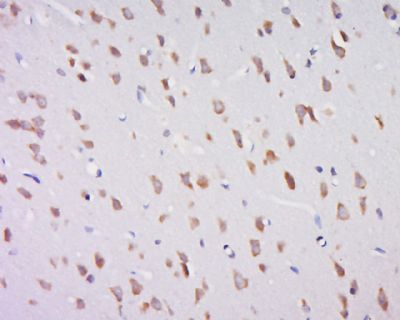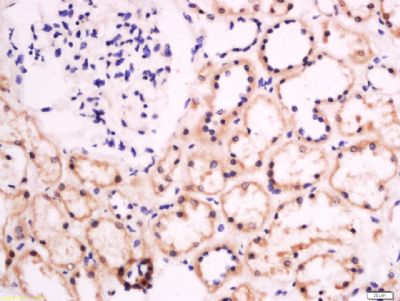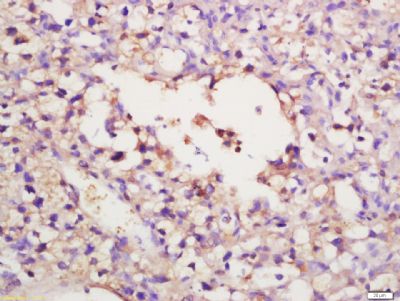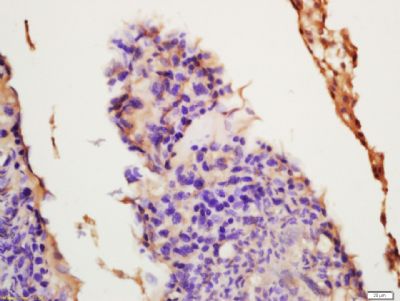Anti-Galactosylceramidase抗体
产品名称: Anti-Galactosylceramidase抗体
英文名称: Galactosylceramidase
产品编号: YB--13251R
产品价格: null
产品产地: 中国/美国
品牌商标: Ybscience
更新时间: 2023-08-17T10:29:50
使用范围: 科研使用
上海钰博生物科技有限公司
- 联系人 : 陈环环
- 地址 : 上海市沪闵路6088号龙之梦大厦8楼806室
- 邮编 : 200612
- 所在区域 : 上海
- 电话 : 183****2235
- 传真 : 021-60514606
- 邮箱 : shybio@126.com
Anti-Galactosylceramidase抗体
| 产品编号 | YB-13251R |
| 英文名称 | Galactosylceramidase |
| 中文名称 | 半乳糖神经酰胺酶抗体 |
| 别 名 | Gacy; Galactocerebrosidase; Galactocerebroside beta galactosidase; Galactosylceramide beta galactosidase; galactosylceraminidase; Galc; GALCERase; Twitcher; GALC_HUMAN. |
| 规格价格 | 100ul/1380元 购买 200ul/2200元 购买 大包装/询价 |
| 说 明 书 | 100ul 200ul |
| 研究领域 | 肿瘤 细胞生物 神经生物学 信号转导 新陈代谢 |
| 抗体来源 | Rabbit |
| 克隆类型 | Polyclonal |
| 交叉反应 | Human, Mouse, Rat, Chicken, Dog, Pig, Cow, Horse, Rabbit, Sheep, |
| 产品应用 | ELISA=1:500-1000 IHC-P=1:400-800 IHC-F=1:400-800 ICC=1:100-500 IF=1:100-500 (石蜡切片需做抗原修复) not yet tested in other applications. optimal dilutions/concentrations should be determined by the end user. |
| 分 子 量 | 73kDa |
| 细胞定位 | 细胞浆 |
| 性 状 | Lyophilized or Liquid |
| 浓 度 | 1mg/ml |
| 免 疫 原 | KLH conjugated synthetic peptide derived from human G protein-regulated inducer of neurite outgrowth 2:81-180/685 |
| 亚 型 | IgG |
| 纯化方法 | affinity purified by Protein A |
| 储 存 液 | 0.01M TBS(pH7.4) with 1% BSA, 0.03% Proclin300 and 50% Glycerol. |
| 保存条件 | Store at -20 癈 for one year. Avoid repeated freeze/thaw cycles. The lyophilized antibody is stable at room temperature for at least one month and for greater than a year when kept at -20癈. When reconstituted in sterile pH 7.4 0.01M PBS or diluent of antibody the antibody is stable for at least two weeks at 2-4 癈. |
| PubMed | PubMed |
| 产品介绍 | background: GALC is a lysosomal enzyme that hydrolyzes galactose ester bonds in various galactolipids, including galactosylceramide, galactosylsphingosine, lactosylceramide and monogalactosyldiglyceride. Galactolipids contain glucose and/or galactose, and are found in the brain and other nerve tissue, especially the myelin sheath. Galactosylceramide is a major lipid in myelin, kidney, and epithelial cells of the small intestine and colon. Mutations in the GALC gene that compromise protein function correlate to Krabbe disease (globoid cell leukodystrophy, GLD). GLD is an autosomal recessive condition that affects approximately 1 in 150,000 infants and results in progressive destruction of the nervous system. The “twitcher” mouse is a model system for GLD; the genotype is a premature stop codon (W339X) in the galactosylceramidase (GALC) gene that abolishes enzymatic activity. Alternate transcriptional splice variants, encoding different isoforms, have been characterized. Function: Galactosylceramidase hydrolyzes the galactose ester bonds of galactosylceramide, galactosylsphingosine, lactosylceramide, and monogalactosyldiglyceride. It is an enzyme with very low activity responsible for the lysosomal catabolism of galactosylceramide, a major lipid in myelin, kidney and epithelial cells of small intestine and colon. It shows highest level of activity in testes compared to brain, kidney, placenta and liver. It can also be found in urine. Defects in Galactosylceramidase are the cause of globoid cell leukodystrophy (GLD); also known as Krabbe disease. This autosomal recessive disorder results in the insufficient catabolism of several galactolipids that are important in the production of normal myelin. Clinically, the most frequent form is the infantile form. Most patients (90%) present before six months of age with irritability, spasticity, arrest of motor and mental development, and bouts of temperature elevation without infection. This is followed by myoclonic jerks of arms and legs, oposthotonus, hypertonic fits, and mental regression, which progresses to a severe decerebrate condition with no voluntary movements and death from respiratory infections or cerebral hyperpyrexia before 2 years of age. However, a significant number of cases with later onset, presenting with unexplained blindness, weakness and/or progressive motor, and sensory neuropathy that can progress to severe mental incapacity and death, have been identified. Subcellular Location: Lysosomal. Tissue Specificity: Highest level of activity in testes compared to brain, kidney, placenta and liver. Can also be found in urine. DISEASE: Defects in GALC are the cause of leukodystrophy globoid cell (GLD) [MIM:245200]; also known as Krabbe disease. This autosomal recessive disorder results in the insufficient catabolism of several galactolipids that are important in the production of normal myelin. Clinically, the most frequent form is the infantile form. Most patients (90%) present before six months of age with irritability, spasticity, arrest of motor and mental development, and bouts of temperature elevation without infection. This is followed by myoclonic jerks of arms and legs, oposthotonus, hypertonic fits, and mental regression, which progresses to a severe decerebrate condition with no voluntary movements and death from respiratory infections or cerebral hyperpyrexia before 2 years of age. However, a significant number of cases with later onset, presenting with unexplained blindness, weakness and/or progressive motor, and sensory neuropathy that can progress to severe mental incapacity and death, have been identified. Similarity: Belongs to the glycosyl hydrolase 59 family. SWISS: P54803 Gene ID: 2581 Database links: Entrez Gene: 533428 Cow Entrez Gene: 403916 Dog Entrez Gene: 2581 Human Entrez Gene: 14420 Mouse Entrez Gene: 314360 Rat Omim: 606890 Human SwissProt: P54804 Dog SwissProt: P54803 Human SwissProt: P54818 Mouse Unigene: 41497 Cow Unigene: 3777 Dog Unigene: 513439 Human Unigene: 5120 Mouse Unigene: 30608 Rat Important Note: This product as supplied is intended for research use only, not for use in human, therapeutic or diagnostic applications. |
| 产品图片 |
 Tissue/cell: Rat brain tissue; 4% Paraformaldehyde-fixed and paraffin-embedded;
Antigen retrieval: citrate buffer ( 0.01M, pH 6.0 ), Boiling bathing for 15min; Block endogenous peroxidase by 3% Hydrogen peroxide for 30min; Blocking buffer (normal goat serum,C-0005) at 37℃ for 20 min; Incubation: Anti-GALC Polyclonal Antibody, Unconjugated(bs-13251R) 1:500, overnight at 4°C, followed by conjugation to the secondary antibody(SP-0023) and DAB(C-0010) staining  Tissue/cell: human kidney tissue; 4% Paraformaldehyde-fixed and paraffin-embedded;
Antigen retrieval: citrate buffer ( 0.01M, pH 6.0 ), Boiling bathing for 15min; Block endogenous peroxidase by 3% Hydrogen peroxide for 30min; Blocking buffer (normal goat serum,C-0005) at 37℃ for 20 min; Incubation: Anti-GALC Polyclonal Antibody, Unconjugated(bs-13251R) 1:200, overnight at 4°C, followed by conjugation to the secondary antibody(SP-0023) and DAB(C-0010) staining  Tissue/cell: mouse placenta tissue; 4% Paraformaldehyde-fixed and paraffin-embedded;
Antigen retrieval: citrate buffer ( 0.01M, pH 6.0 ), Boiling bathing for 15min; Block endogenous peroxidase by 3% Hydrogen peroxide for 30min; Blocking buffer (normal goat serum,C-0005) at 37℃ for 20 min; Incubation: Anti-GALC/Galactosylceramidase Polyclonal Antibody, Unconjugated(bs-13251R) 1:200, overnight at 4°C, followed by conjugation to the secondary antibody(SP-0023) and DAB(C-0010) staining  Tissue/cell: rat testis tissue; 4% Paraformaldehyde-fixed and paraffin-embedded;
Antigen retrieval: citrate buffer ( 0.01M, pH 6.0 ), Boiling bathing for 15min; Block endogenous peroxidase by 3% Hydrogen peroxide for 30min; Blocking buffer (normal goat serum,C-0005) at 37℃ for 20 min; Incubation: Anti-GALC/Galactosylceramidase Polyclonal Antibody, Unconjugated(bs-13251R) 1:200, overnight at 4°C, followed by conjugation to the secondary antibody(SP-0023) and DAB(C-0010) staining |
